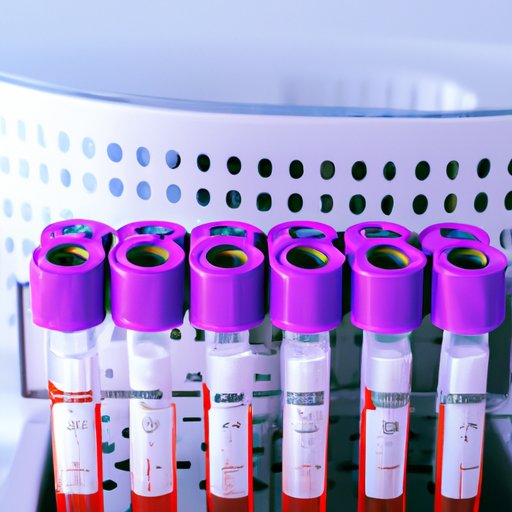Introduction
A blood culture is a laboratory test used to identify bacteria, fungi, or other organisms in the blood. It is often used when a person has a fever, chills, and other symptoms that suggest an infection. The purpose of this article is to help people understand what a blood culture is and how it can be used to diagnose and treat infections.
Exploring What a Blood Culture Is and Its Uses
A blood culture is a laboratory test performed on a sample of a person’s blood. The test is used to identify bacteria, fungi, or other organisms in the blood that may be causing an infection. When a person has symptoms such as fever, chills, and fatigue, a doctor may order a blood culture to determine if an infection is present.
The procedure for a blood culture involves taking a sample of blood from a patient and placing it into a sterile container. The sample is then sent to a laboratory where it is incubated in a special environment. During the incubation process, any bacteria or other organisms present in the sample will begin to grow and multiply. Once the incubation period is complete, the sample is examined under a microscope to identify the type of organism present.
The results of a blood culture can provide valuable information about the type of infection present and the best course of treatment. If bacteria are present in the sample, the lab will be able to identify the type of bacteria and determine which antibiotics will be most effective in treating the infection. In some cases, a blood culture may also be used to detect the presence of fungi or viruses in the sample.
A Deeper Look Into the Process of a Blood Culture Test
A blood culture test is a relatively straightforward procedure, but there are several steps involved. Here is a step-by-step guide to performing a blood culture test:
- Obtain a sample of blood from the patient using a sterile needle and syringe.
- Place the sample into a sterile container and label it with the patient’s name, date, and time.
- Send the sample to a laboratory for processing.
- At the laboratory, the sample is placed in an incubator and monitored for any signs of growth.
- Once the incubation period is complete, the sample is examined under a microscope to identify the type of organism present.
There are several different types of blood cultures that can be used to detect different types of organisms. Aerobic cultures are used to detect bacteria that require oxygen to grow, while anaerobic cultures are used to detect bacteria that do not need oxygen to grow. Automated systems are also available that can quickly detect the presence of bacteria in a sample. In addition, enzymatic tests can be used to detect the presence of fungi in a sample.

The Benefits of a Blood Culture Test
A blood culture test can provide valuable information about the type of infection present and the best course of treatment. It can also help to improve the accuracy of a diagnosis and reduce the risk of complications from an infection. Here are some of the benefits of a blood culture test:
- Improved diagnosis of infections – A blood culture test can provide more accurate information than other diagnostic tests, allowing doctors to make better decisions about treatment.
- Early detection of infections – By detecting an infection sooner, doctors can begin treatment earlier, reducing the risk of complications.
- Reduction in the risk of complications from infections – Early detection and treatment of infections can reduce the risk of serious complications, such as organ damage or sepsis.
In addition, a blood culture test is a relatively quick and inexpensive procedure, making it a cost-effective way to diagnose infections.

Understanding the Different Types of Blood Cultures
As mentioned above, there are several different types of blood cultures that can be used to detect different types of organisms. Aerobic cultures are used to detect bacteria that require oxygen to grow, while anaerobic cultures are used to detect bacteria that do not need oxygen to grow. Automated systems are also available that can quickly detect the presence of bacteria in a sample. In addition, enzymatic tests can be used to detect the presence of fungi in a sample.
It is important to note that not all blood cultures are created equal. Some tests are more sensitive than others, meaning they are able to detect even small amounts of bacteria or other organisms. Other tests may only be able to detect larger amounts of bacteria or other organisms. It is important to speak to your doctor about the type of blood culture test that is best suited for your needs.

What to Expect During a Blood Culture Test
A blood culture test is usually performed as an outpatient procedure. The patient will be asked to sit or lie down in a comfortable position and the area around the injection site will be cleaned with an antiseptic solution. A sterile needle and syringe will then be used to collect a sample of blood, which will be placed in a sterile container and labeled with the patient’s name, date, and time.
Once the sample has been collected, it will be sent to a laboratory for processing. At the laboratory, the sample will be placed in an incubator and monitored for any signs of growth. Once the incubation period is complete, the sample will be examined under a microscope to identify the type of organism present. The results of the test will then be interpreted and reported back to the doctor.
Common Questions About Blood Cultures Answered
Here are some of the most commonly asked questions about blood cultures:
- How long does it take to get results back? – Typically, it takes 2 to 3 days for a lab to process a sample and report the results.
- Are there any risks associated with a blood culture test? – Generally, the risks associated with a blood culture test are minimal.
- What are the chances of getting an inaccurate result? – The accuracy of a blood culture test depends on many factors, including the quality of the sample and the type of test used. However, the accuracy of a blood culture test is generally quite high.
Conclusion
A blood culture is a laboratory test used to identify bacteria, fungi, or other organisms in the blood. It is often used when a person has a fever, chills, and other symptoms that suggest an infection. The procedure for a blood culture involves taking a sample of blood from a patient and sending it to a laboratory for processing. The results of a blood culture can provide valuable information about the type of infection present and the best course of treatment.
There are several different types of blood cultures that can be used to detect different types of organisms. Each type of culture has its own advantages and disadvantages, so it is important to speak to your doctor about which type is best suited for your needs. In addition, a blood culture test is a relatively quick and inexpensive procedure, making it a cost-effective way to diagnose infections.
If you have any questions or concerns about a blood culture test, it is important to speak to your doctor. They will be able to answer any questions you may have and provide advice on the best course of action.
(Note: Is this article not meeting your expectations? Do you have knowledge or insights to share? Unlock new opportunities and expand your reach by joining our authors team. Click Registration to join us and share your expertise with our readers.)
